Greengrocers and fruiterers in 1940s wartime and post-war Britain

The range of produce in greengrocers and fruiterers was severely limited in the 1940s by what could be home grown. This page considers what they could sell, the sales process and inside and outside their shops. It highlights the difference between pre- and post-war shop goods.
____
By the webmaster: her early recollections with further research and contributions from others who lived at the time
What greengrocers sold in the 1940s
All I ever remember my mother buying in our one-and-only greengrocer shop in Edgware during the shortages and austerities of wartime and post-war Britain were potatoes and spring greens, although I suppose she would have bought other vegetables like carrots, cabbages and onions which were either in season of from storage, plus of course fruit in season. Other people of my age report the same thing.
In general, vegetables and fruit were not rationed, although individual shops did create their own informal rationing system of what was in short supply. It was a case of 'first come first served' which was why queues were so long.
In particular potatoes were not rationed during the war (although they were for a year afterwards in the additional austerity) so they were the mainstay of the British diet as they grew well in Britain's climate without having to be imported. In fact, almost no fruit and vegetables were imported during the war, although there was the a special post-war shipment of bananas.
Inside greengrocers
There always seemed to be a queue of women at the door of the greengrocers which was kept permanently open for them, whatever the weather. So the shop was always draughty and in winter it was cold. It was also very scruffy because the potatoes, carrots and other vegetables came straight out of the ground unwashed and unbagged in rough wooden crates. Layers of dust, which was probably dry soil, seemed to cover everywhere.
The sales process
The potatoes and any other earthy vegetables were weighed out for each customer by women in dusty green overalls and headscarves, using the 'balance' type of scales with heavy weights on one side and a large dusty scoop on the other. The potatoes etc were then tipped into brown paper bags, and carried away by customers in their string bags. Cane shopping baskets were the mainstay for most shopping, but the use of string bags for unwashed vegetables kept the dirt out of the shopping baskets.
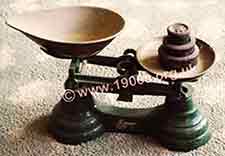
Greengrocer scales.
Note the pointed pan, to make it
easier to tip contents into bags and the heavy weights for
weighing out potatoes.
The women worked at an extremely fast pace, never stopping to chat. This could have been because of the long queues or just their personalities.
The sign outside greengrocers
contributed by Richard Ouston
It was quite usual to have a sign or symbol outside the shop indicating to the passing public what the shopkeeper's trade was, perhaps the most commonly known being the barber's pole. At our greengrocers, Waltons, it was a large bunch of plaster bananas hanging at maybe 10 to 15 feet above the pavement - clearly a relic from pre-war times. I had been told that these were bananas but of course I hadn't ever seen a real banana at that time as they were not available during the war. When I eventually did see one, I was very, very disappointed to find that it was only about 5 or 6 inches long rather than the two or three foot plaster version.
Appearance of wartime greengrocer shops - photo for comparison
I wish I had a photo of a wartime greengrocer shop, but if I did, it would be grey, dirty and dreary. The following photo shows the change from pre-war.
It was given to this website with the comment that it was from the 1940s as a celebration of Empire Day. Yet it is far too luxurious for wartime, or even the period of austerity in the years after the war. Furthermore I don't ever remember any formal recognition of Empire Day when I was a child in the 1940s, although my mother, writing of her schooldays around 1912 remembered the celebrations well. Furthermore the placard advertising apples from Canada is very much in the style of Victorian and Edwardian times, and there is a profusion of bananas.
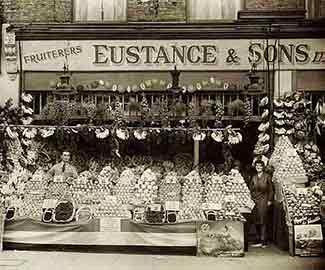
Greengrocers: a special display for the Empire Window Dressing Competition. The shop was in Finsbury Park, north London and belonged to Roy Eustance. The photo is courtesy of his relative Viv Nunn.
Below is an enlargement of the display showing the richness of the range. Note the bananas and grapes at the back which are most definitely imported. The prices of course are marked in the old money of shillings and pence.
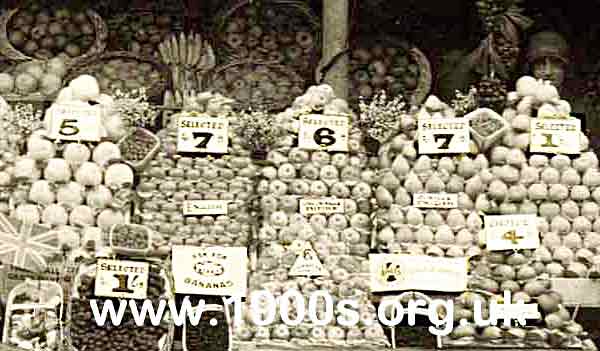
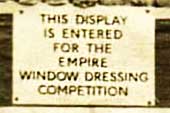
Placard showing the purpose of the display. Detail from the above photo
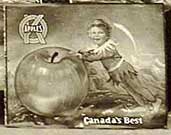
Placard advertising Canadian apples which of course were necessarily imported
The following greengrocer/fruiterer photo was photographed in a museum. It is interesting that although the shop and its attributes are probably genuine for the era, what is on-sale is certainly not. Think instead in terms of potatoes, carrots and cabbages - and British fruit in the summer.
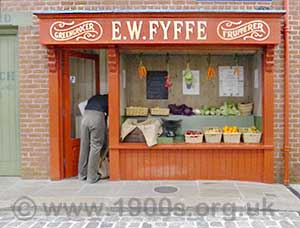
Greengrocer/fruiterer photographed in Milestones museum, Basingstoke.
| sources | webmaster | contact |
Text and images are copyright
If you can add anything to this page or provide a photo, please contact me.



